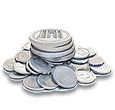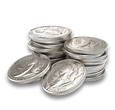How to Build a Diversified Precious Metal Portfolio
- GoldsilverJapan

- Sep 20
- 4 min read
In an unpredictable economic environment, savvy investors are constantly searching for ways to hedge against inflation, currency devaluation, and systemic risks. One of the most time-tested strategies? Investing in precious metals like gold, silver, platinum, and palladium. But owning a single type of metal—or even just one form, such as bullion bars—is not enough. Building a diversified precious metal portfolio is key to long-term stability and growth.
This comprehensive guide answers all the most common questions investors ask—especially first-time buyers—and walks you through how to build a diversified precious metal portfolio step by step.
📌 Why Diversify Your Precious Metals?
Before diving into what to buy, let’s answer the foundational question:
Why diversify within precious metals?
Diversification in any portfolio reduces risk. While precious metals are generally seen as "safe haven" assets, different metals respond differently to market conditions:
Gold is often a hedge against inflation and fiat currency risk.
Silver is more volatile and tied to industrial demand.
Platinum and palladium are influenced heavily by the auto and electronics industries.
By owning a mix, you reduce reliance on the performance of any one metal.
🪙 Precious Metals to Include in Your Portfolio
1. Gold: The Foundation
Gold remains the bedrock of any diversified metals portfolio. It has:
High liquidity worldwide
Millennia of cultural and economic relevance
Strong performance during currency devaluation or geopolitical uncertainty
Popular forms of gold to consider:
Bullion Coins – e.g., American Gold Eagle, Canadian Gold Maple Leaf, Austrian Philharmonic
Bars – 1 oz, 10 oz, 1 kg bars from trusted refiners (e.g., Tanaka Kikinzoku, PAMP Suisse)
Pre-1933 Coins – like U.S. $20 Saint-Gaudens or British Sovereigns for semi-numismatic appeal
➡️ Allocation Tip: Many conservative investors allocate 50–70% of their metal portfolio to gold.
2. Silver: The Accessible Metal
Silver offers affordability and high upside potential due to industrial use in electronics, solar panels, and batteries. It tends to be more volatile than gold—great for those looking for price swings.
Forms of silver to consider:
Silver Bullion Coins – e.g., American Silver Eagle, Canadian Maple Leaf, Australian Kangaroo
Junk Silver – 90% silver U.S. coins (pre-1965), Japanese 50 sen and 100 yen silver coins
Silver Bars – Ranging from 1 oz to 100 oz, good for bulk storage
Collectible Series – e.g., Queen’s Beasts, Australian Swan, and others
➡️ Allocation Tip: 20–40% of your portfolio in silver offers balance and liquidity.
3. Platinum and Palladium: The Strategic Edge
These two metals are lesser-known but offer strategic diversification. They’re rarer than gold and silver, and prices often move independently due to:
Automotive demand (catalytic converters)
Industrial manufacturing
Geopolitical supply risks (e.g., Russian palladium)
Investment Options:
Platinum Coins – Canadian Maple Leaf, American Eagle (less common)
Palladium Bars – From mints like Credit Suisse or Tokuriki Honten
Exchange-traded metals (only for advanced investors comfortable with digital holdings)
➡️ Allocation Tip: Limit to 5–10% unless you understand industrial demand cycles.
🧱 Choosing the Right Forms: Bars, Coins, or Rounds?
🟡 Coins
Legal tender
Government-backed purity and weight
Highly liquid and recognizable
Higher premiums
🟩 Bars
Lower premiums
Easier for large-scale investments
Require testing or certification for resale
🔵 Rounds
Produced by private mints
Not legal tender
Affordable and liquid
🇯🇵 What About Japanese Buyers? (GoldSilverJapan Customers)
If you're buying from Japan, you have specific, high-trust options that aren’t always available elsewhere.
Trusted Sellers:
GoldSilverJapan – Reliable source of physical bullion with domestic delivery and authentication
Tanaka Kikinzoku – Known for high-quality gold bars and digital gold accounts
Tokuriki Honten – Offers platinum and palladium products, including refining services
These domestic options help Japanese investors bypass import taxes and build their portfolio with more confidence.
🧠 How to Allocate Your Metals by Investment Goal
Goal | Suggested Allocation | Key Products |
Hedge against inflation | 70% gold, 30% silver | Gold Eagles, Silver Maples |
Growth and speculation | 40% gold, 50% silver, 10% platinum/palladium | Silver bars, collectible coins |
Short-term liquidity | 60% coins, 40% small bars | 1 oz coins, 1g gold bars |
Long-term wealth preservation | 70% large bars, 30% coins | 1 kg gold bars, sovereigns |
🔍 FAQs About Building a Precious Metal Portfolio
❓ Can I start small?
Absolutely. You can start with:
A silver dime for $3
A 1g gold bar for about $150
A fractional gold coin (1/10 oz) for ~$400–$500
Over time, you can expand.
❓ Should I buy everything at once?
Not necessarily. Consider dollar-cost averaging—buying small amounts regularly to avoid timing the market.
❓ Is it better to focus on bars or coins?
Coins are more liquid and universally trusted, while bars offer better value per gram. Combine both for flexibility.
❓ How should I store precious metals?
You have several options:
Home safes – Make sure it’s fireproof and well hidden
Bank safety deposit boxes
Third-party vaults – Like those offered by GoldSilverJapan or Tanaka Kikinzoku
❓ How do I verify my metals are real?
Buy from trusted dealers
Look for assay cards and serial numbers
Use testing tools (magnet, scale, caliper)
For large purchases, consider XRF scanning
🌎 Geographic Diversification Matters Too
Some investors like to store metals across different countries to reduce local economic and political risks. For example:
Keep part of your stack in Japan
Use Singapore vaults for offshore storage
Use U.S.-based dealers with global vault access
🔄 Rebalancing Your Portfolio
As market prices shift, your gold-to-silver (or other) ratio may drift. Rebalancing every 6–12 months can:
Lock in gains
Keep your risk levels stable
Ensure long-term alignment with your goals
🛑 What to Avoid
High-premium collectible coins unless you’re a collector
Untrusted or unverified sellers
Over-concentration in a single metal
Digital-only metals without full backing
🏁 Final Thoughts: Start Smart, Build Steady
Building a diversified precious metal portfolio isn’t about chasing the highest return—it’s about creating financial resilience. Whether you’re a first-time buyer in Japan looking to protect your yen, or a global investor wanting to hedge against fiat risk, precious metals offer a stable foundation.
Stick to your goals. Mix gold, silver, and a bit of platinum or palladium. Use trusted dealers like GoldSilverJapan, and rebalance periodically. That’s how real wealth preservation begins.
If you want help getting started with physical delivery in Japan, visit GoldSilverJapan for the latest availability of bullion coins, bars, and fractional gold.
Let your stack grow smart—one ounce at a time.











Comments